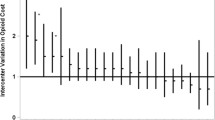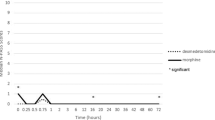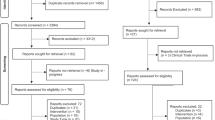Abstract
Objectives
To evaluate the use of sedatives and analgesics during therapeutic hypothermia in encephalopathic neonates and assess associations between medication exposure and hospital outcomes.
Study design
We identified neonates ≥35 weeks gestational age treated with therapeutic hypothermia at 125 neonatal intensive care units between 2007 and 2015. We compared characteristics and hospital outcomes between unexposed neonates and neonates exposed to opioids and/or benzodiazepines.
Results
Opioids were administered to 1 677/2 621 (64%) neonates, and exposure increased from 38% in 2008 to 68% in 2015. Sedation/analgesia varied widely between centers. Opioid-exposed neonates experienced greater durations of respiratory support and were more likely to receive inotropes and inhaled nitric oxide. Mortality during postnatal days 0–3 was lower among opioid-exposed neonates (31/625 [5%]) than unexposed neonates (64/714 [9%]).
Conclusions
Sedation/analgesia during therapeutic hypothermia is prevalent but not uniform across centers. Prospective studies are needed to assess if exposure independently predicts intensity and duration of physiologic support.
This is a preview of subscription content, access via your institution
Access options
Subscribe to this journal
Receive 12 print issues and online access
$259.00 per year
only $21.58 per issue
Buy this article
- Purchase on Springer Link
- Instant access to full article PDF
Prices may be subject to local taxes which are calculated during checkout



Similar content being viewed by others
References
Lee ACC, Kozuki N, Blencowe H, Vos T, Bahalim A, Darmstadt GL, et al. Intrapartum-related neonatal encephalopathy incidence and impairment at regional and global levels for 2010 with trends from 1990. Pediatr Res. 2013;74:50–72.
Shankaran Seetha. Therapeutic hypothermia for neonatal encephalopathy. Curr Treat Options Neurol. 2012;14:608–19.
Sarnat HB, Sarnat MS. Neonatal encephalopathy following fetal distress: a clinical and electrographic study. Arch Neurol. 1976;33:696–705.
Shankaran S, Laptook AR, Ehrenkranz RA, Tyson JE, McDonald SA, Donovan EF. National Institute of Child Health and Human Development Neonatal Research Network et al. Whole-body hypothermia for neonates with hypoxic-ischemic encephalopathy. N Engl J Med. 2005;353:1574–84.
Shankaran S, Natarajan G, Chalak L, Pappas A, McDonald SA, Laptook AR. Hypothermia for neonatal hypoxic-ischemic encephalopathy: NICHD Neonatal Research Network contribution to the field. Semin Perinatol. 2016;40:385–90.
Jacobs SE, Morley CJ, Inder TE, Stewart MJ, Smith KR, McNamara PJ, et al. Whole-body hypothermia for term and near-term newborns with hypoxic-ischemic encephalopathy: a randomized controlled trial. Arch Pediatr Adolesc Med. 2011;165:692–700.
Azzopardi DV, Strohm S, Edwards AD, Dyet L, Halliday HL, Juszczak E. TOBY Study Group et al. Moderate hypothermia to treat perinatal asphyxial encephalopathy. N Engl J Med. 2009;361:1349–58.
Simbruner G, Mittal RA, Rholmann F, Muche R. neo.nEURO.network Trial Participants Systemic hypothermia after neonatal encephalopathy: outcomes of neo.nEURO.network RCT. Pediatrics. 2010;126:e771–8.
Higgins RD, Raju T, Edwards AD, Azzopardi DV, Bose CL, Clark RH, et al. Hypothermia and other treatment options for neonatal encephalopathy: an executive summary of the eunice kennedy shriver national institute of child health and human development workshop. J Pediatr. 2011;159:851–58.
Kracer B, Hintz SR, Van Meurs KP, Lee HC. Hypothermia therapy for neonatal hypoxic ischemic encephalopathy in the state of California. J Pediatr. 2014;165:267–73.
Wassink G, Lear CA, Gunn K, Dean JM, Bennet L, Gunn AJ. Analgesics, sedatives, anticonvulsant drugs, and the cooled brain. Semin Fetal Neonatal Med. 2015;20:109–14.
Angeles DM, Wycliffe N, Michelson D, Holshouser BA, Deming DD, Pearce WJ, et al. Use of opioids in asphyxiated term neonates: effects on neuroimaging and clinical outcome. Pediatr Res. 2005;57:873–8.
Grunau RE, Holsti L, Peters JWB. Long-term consequences of pain in human neonates. Semin Fetal Neonatal Med. 2006;11:268–75.
Thoresen M, Satas S, Loberg EM, Whitelaw A, Acolet D, Lindgren C, et al. Twenty-four hours of mild hypothermia in unsedated newborn pigs starting after a severe global hypoxic-ischemic insult is not neuroprotective. Pediatr Res. 2001;50:405–11.
Atici S, Cinel L, Cinel I, Doruk N, Aktekin M, Akca A, et al. Opioid neurotoxicity: comparison of morphine and tramadol in an experimental rat model. Int J Neurosci. 2004;114:1001–11.
Juul SE, Beyer RP, Bammler TK, Farin FM, Gleason CA. Effect of neonatal stress and morphine on murine hippocampal gene expression. Pediatr Res. 2010;69:285–92.
Festekjian A, Ashwal S, Obenaus A, Angeles DM, Denmark TK. The role of morphine in a rat model of hypoxic-ischemic injury. Pediatr Neurol. 2011;45:77–82.
Roka A, Melinda KT, Vasarhelyi B, Machay T, Azzopardi D, Szabo M. Elevated morphine concentrations in neonates treated with morphine and prolonged hypothermia for hypoxic ischemic encephalopathy. Pediatrics. 2008;121:e844–9.
Frymoyer A, Bonifacio S, Drover D, Su F, Wustoff CJ, Van Meurs KP. Decreased morphine clearance in neonates with hypoxic ischemic encephalopathy receiving hypothermia. J Clin Pharm. 2016;0:1–13.
Spitzer AR, Ellsbury DL, Handler D, Clark RH. The pediatrix babysteps data warehouse and the pediatrix qualitysteps improvement project system—tools for “meaningful use” in continuous quality improvement. Clin Perinatol 2010;37:49–70. [dataset]
Anand KJS, Clark AE, Willson DF, Berger J, Meert KL, Zimmerman JJ. Eunice Kennedy Shriver National Institute of Child Health and Human Development (NICHD) Collaborative Pediatric Critical Care Research Network (CPCCRN) et al. Collaborative Pediatric Critical Care Research Network (CPCCRN). Opioid analgesia in mechanically ventilated children: results from the multicenter Measuring Opioid Tolerance Induced by Fentanyl (MOTIF) study. Pediatr Crit Care Med. 2013;14:27–36.
Anand KJ. Pain panacea for opiophobia in infants? JAMA. 2013;309:183–4.
Zimmerman KO, Smith PB, Benjamin DK, Laughon M, Clark R, Traube C, et al. Sedation, analgesia, and paralysis during mechanical ventilation of premature infants. J Pediatr. 2017;180:99–104.
Moler FW, Silverstein FS, Holubkov R, Slomine BS, Christensen JR, Nadkarni VM, et al. THAPCA trial investigators. Therapeutic hypothermia after out-of-hospital cardiac arrest in children. N Engl J Med. 2015;372:1898–908.
May TL, Seder DB, Fraser GL, Stone P, McCrum B, Riker RR. Moderate-dose sedation and analgesia during targeted temperature management after cardiac arrest. Neurocrit Care. 2015;22:105–11.
Anand KJS. Consensus statement for the prevention and management of pain in the newborn. Arch Pediatr Adolesc Med. 2001;155:173–80.
Anand KJ, Johnston CC, Oberlander TF, Taddio A, Lehr VT, Walco GA. Analgesia and local anesthesia during invasive procedures in the neonate. Clin Ther. 2005;27:844–76.
Carbajal R, Eriksson M, Courtois E, Boyle E, Avila-Alvarez A, Andersen RD. EUROPAIN Survey Working Group et al. Sedation and analgesia practices in neonatal intensive care units (EUROPAIN): results from a prospective cohort study. Lancet Respir Med. 2015;3:796–812.
Char DS. Negotiating the dilemma of anaesthesia and sedation in NICUs. Lancet Respir Med. 2015;3:741–2.
Jegatheesan P, Morgan A, Shimotake T, Song D, Van Meurs K, Perinatal Quality Improvement Panel (PQIP), California perinatal quality care collaborative (CPQCC). Early screening and identification of candidates for neonatal hypothermia toolkit. https://www.cpqcc.org/sites/default/files/FINAL%20HIE%20Toolkit_2-15-15%20California%20Perinatal%20Quality%20Care%20Collaborative.pdf. Accessed Feb 2015.
Florida Neonatal Neurologic Network. systemic hypothermia in neonates with hypoxic-ischemic encephalopathy (HIE). https://fn3.sites.medinfo.ufl.edu/files/2017/12/State-of-Florida-protocol-8-5-2017.pdf. Accessed Aug 2017.
Hummel P, Pulchalski M, Creech SD, Weiss MG. Clinical reliability and validity of the N-PASS: neonatal pain, agitation, and sedation scale with prolonged pain. J Perinat. 2008;28:55–60.
Hummel P, Lawlor-Klean P, Weiss MG. Validity and reliability of the N-PASS assessment tool with acute pain. J Perinatol. 2010;30:474–8.
American Academy of Pediatrics and Canadian Paediatric Society, Batton DG, Barrington KJ, Wallman C. Prevention and management of pain in the neonate: an update. Pediatrics 2006;118:2231–41.
Hillman BA, Tabrizi MN, Gauda EB, Carson KA, Aucott SW. The neonatal pain, agitation and sedation scale and the bedside nurse’s assessment of neonates. J Perinatol. 2015;35:128–31.
Stevens B, McGrath P, Yamada J, Gibbins S, Beyene J, Breau L, et al. Identification of pain indicators for infants at risk for neurological impairment: a Delphi consensus study. BMC Pediatr. 2006;6:1.
Natarajan G, Shankaran S, Laptook AR, McDonald SA, Pappas A, Hintz SR. NICHD Neonatal Research Network Whole Body Hypothermia Subcommittee et al. Association between sedation-analgesia and neurodevelopmental outcomes in neonatal hypoxic-ischemic encephalopathy. J Perinatol. 2018; https://doi.org/10.1038/s41372-018-0126-7.
Funding
Our manuscript represents original work, is not under consideration for publication elsewhere, and has not been previously published, except in abstract form at the Pediatric Academic Societies annual meetings in 2017 (between center variation) and 2018 (outcome comparisons). This study was not financially supported or sponsored. MWB composed the first draft of the manuscript. No honorarium, grant, or other form of payment was provided to any author in exchange for producing the manuscript.
Author information
Authors and Affiliations
Corresponding author
Ethics declarations
Conflict of interest
RCG has received support from industry for research services (https://dcri.org/about-us/conflict-of-interest/). MEL receives funding from the National Institute of Neurological Disorders and Stroke of the National Institutes of Health (K12NS098482) and the Derfner Foundation. CMC receives funding for work related to interventions for hypoxic-ischemic encephalopathy from the Eunice Kennedy Shriver NICHD Neonatal Research Network Grant: 5U10 HD040492-10, and the Duke National Center for Advancing Translational Sciences (NCATS) 1UL1-TR002553. MWB, MB, CEP, and VNT declare that they have no conflict of interest.
Additional information
Publisher’s note Springer Nature remains neutral with regard to jurisdictional claims in published maps and institutional affiliations.
Rights and permissions
About this article
Cite this article
Berube, M.W., Lemmon, M.E., Pizoli, C.E. et al. Opioid and benzodiazepine use during therapeutic hypothermia in encephalopathic neonates. J Perinatol 40, 79–88 (2020). https://doi.org/10.1038/s41372-019-0533-4
Received:
Revised:
Accepted:
Published:
Issue Date:
DOI: https://doi.org/10.1038/s41372-019-0533-4
This article is cited by
-
Predictive value of the Thompson score for short-term adverse outcomes in neonatal encephalopathy
Pediatric Research (2023)
-
Interventions for the Management of Pain and Sedation in Newborns Undergoing Therapeutic Hypothermia for Hypoxic-Ischemic Encephalopathy: A Systematic Review
Pediatric Drugs (2023)
-
Opioid exposure during therapeutic hypothermia and short-term outcomes in neonatal encephalopathy
Journal of Perinatology (2022)
-
Emerging therapies and management for neonatal encephalopathy—controversies and current approaches
Journal of Perinatology (2021)



